Therapeutic Potential of Rosa davurica Pall. Root Extract as an Antidiabetic Agent: A Comprehensive Analysis from Molecular Mechanisms to In Vivo Efficacy
Abstract
:1. Introduction
2. Results
2.1. Polyphenol Content of RDR and Its Antioxidant and Radical Scavenging Activities
2.2. α-Glucosidase Inhibitory Activities of RDR
2.3. Effects of RDR on Glucose Uptake in C2C12 Cells
2.4. Effects of RDR on the PI3K/Akt Signaling Cascade
2.5. Effects of RDR on AMPK Signaling
2.6. Effects of RDR on Glucose Transporter Type 4
2.7. Effect of RDR on Symptoms of Diabetes Mellitus (DM) in STZ-Induced Diabetic Rats
2.8. Effects of RDR on Blood Glucose and Liver and Kidney Functions in STZ-Induced Diabetic Rats
2.9. Effects of RDR on Pancreatic Function in STZ-Induced Diabetic Rats
2.10. Identification of Phytochemical Compounds in RDR through GC–MS Chromatogram
2.11. Molecular Docking Analysis of the Potential Interaction between the Main Components in RDR and GLUT4
3. Discussion
4. Materials and Methods
4.1. Chemicals and Reagents
4.2. Preparation of R. davurica Pall. Extracts
4.3. Determination of Total Polyphenols
4.4. DPPH Radical Scavenging Assay
4.5. Reducing Power Assay
4.6. Cell Culture and Cytotoxicity Assay
4.7. α-Glucosidase Inhibitory Activities
4.8. Measurement of Glucose Uptake
- (1)
- 10 μL of the samples (or standard) was mixed with 10 μL of 4% phenol acid in an e-tube.
- (2)
- After 5 min, 100 μL of sulfuric acid was added to the e-tube with the mixture, and then the e-tube was placed in a 30 °C water bath for 30 min.
- (3)
- The reaction was adapted to a 96-well format, where 50 μL of the mixture was blended with 50 μL of distilled water, and the absorbance was assessed at 490 nm using a GENios® spectrophotometer (BioTek Instruments, Inc., Winooski, VT, USA). The glucose uptake was quantified based on the standard curve. The results were presented as a fold-increase from their respective controls (vehicle alone).
4.9. Isolation of Cytosolic and Plasma Membrane Fraction Proteins
4.10. Western Blotting
4.11. Animals
4.12. Induction of Diabetes Rat Model and Treatment of RDR
- Group I—Control (normal rats administered with saline)
- Group II—STZ (diabetic rats administered with saline)
- Group III—STZ + RDR (diabetic rats administered with a low dosage of RDR, 100 mg/kg)
- Group IV—STZ + RDR (diabetic rats administered with a high dosage of RDR, 500 mg/kg)
- Group V—STZ + MET (diabetic rats administered with metformin, 200 mg/kg).
4.13. Blood Biochemical Analysis
4.14. Histological Analysis
4.15. GC Analysis
4.16. Molecular Docking Analysis
4.17. Statistical Analysis
5. Conclusions
Supplementary Materials
Author Contributions
Funding
Institutional Review Board Statement
Informed Consent Statement
Data Availability Statement
Conflicts of Interest
References
- Erejuwa, O.O.; Sulaiman, S.A.; Ab Wahab, M.S. Honey: A Novel Antioxidant. Molecules 2012, 17, 4400–4423. [Google Scholar] [CrossRef] [PubMed]
- Lobo, V.; Patil, A.; Phatak, A.; Chandra, N. Free radicals, antioxidants and functional foods: Impact on human health. Pharmacogn. Rev. 2010, 4, 118–126. [Google Scholar] [CrossRef] [PubMed]
- Patel, D.; Kumar, R.; Prasad, S.; Sairam, K.; Hemalatha, S. Antidiabetic and in vitro antioxidant potential of Hybanthus enneaspermus (Linn) F. Muell in streptozotocin–induced diabetic rats. Asian Pac. J. Trop. Biomed. 2011, 1, 316–322. [Google Scholar] [CrossRef] [PubMed]
- Brownlee, M. Biochemistry and molecular cell biology of diabetic complications. Nature 2001, 414, 813–820. [Google Scholar] [CrossRef] [PubMed]
- DeFronzo, R.A.; Jacot, E.; Jequier, E.; Maeder, E.; Wahren, J.; Felber, J.P. The Effect of Insulin on the Disposal of Intravenous Glucose: Results from Indirect Calorimetry and Hepatic and Femoral Venous Catheterization. Diabetes 1981, 30, 1000–1007. [Google Scholar] [CrossRef] [PubMed]
- Saltiel, A.R.; Kahn, C.R. Insulin signalling and the regulation of glucose and lipid metabolism. Nature 2001, 414, 799–806. [Google Scholar] [CrossRef]
- Taniguchi, C.M.; Emanuelli, B.; Kahn, C.R. Critical nodes in signalling pathways: Insights into insulin action. Nat. Rev. Mol. Cell Biol. 2006, 7, 85–96. [Google Scholar] [CrossRef] [PubMed]
- Tripathy, D.; Chavez, A.O. Defects in Insulin Secretion and Action in the Pathogenesis of Type 2 Diabetes Mellitus. Curr. Diabetes Rep. 2010, 10, 184–191. [Google Scholar] [CrossRef]
- Manning, B.D.; Cantley, L.C. AKT/PKB Signaling: Navigating Downstream. Cell 2007, 129, 1261–1274. [Google Scholar] [CrossRef]
- Bouzakri, K.; Koistinen, H.; Zierath, J. Molecular Mechanisms of Skeletal Muscle Insulin Resistance in Type 2 Diabetes. Curr. Diabetes Rev. 2005, 1, 167–174. [Google Scholar] [CrossRef]
- Mackenzie, R.; Elliott, B. Akt/PKB activation and insulin signaling: A novel insulin signaling pathway in the treatment of type 2 diabetes. Diabetes Metab. Syndr. Obes. Targets Ther. 2014, 7, 55–64. [Google Scholar] [CrossRef] [PubMed]
- Hardie, D.G. The AMP-Activated Protein Kinase Pathway—New Players Upstream and Downstream. J. Cell Sci. 2004, 117, 5477–5487. [Google Scholar] [CrossRef]
- Fryer, L.; Carling, D. AMP-activated protein kinase and the metabolic syndrome. Biochem. Soc. Trans. 2005, 33, 362–366. [Google Scholar] [CrossRef]
- Fryer, L.G.D.; Parbu-Patel, A.; Carling, D. The Anti-diabetic Drugs Rosiglitazone and Metformin Stimulate AMP-activated Protein Kinase through Distinct Signaling Pathways. J. Biol. Chem. 2002, 277, 25226–25232. [Google Scholar] [CrossRef] [PubMed]
- Zhou, G.; Myers, R.; Li, Y.; Chen, Y.; Shen, X.; Fenyk-Melody, J. Role of AMP-Activated Protein Kinase in Mechanism of Metformin Action. J. Clin. Investig. 2001, 108, 1167–1174. [Google Scholar] [CrossRef] [PubMed]
- Zygmunt, K.; Faubert, B.; MacNeil, J.; Tsiani, E. Naringenin, a citrus flavonoid, increases muscle cell glucose uptake via AMPK. Biochem. Biophys. Res. Commun. 2010, 398, 178–183. [Google Scholar] [CrossRef] [PubMed]
- Breen, D.M.; Sanli, T.; Giacca, A.; Tsiani, E. Stimulation of muscle cell glucose uptake by resveratrol through sirtuins and AMPK. Biochem. Biophys. Res. Commun. 2008, 374, 117–122. [Google Scholar] [CrossRef]
- Kang, S.-Y.; Kim, E.; Kang, I.; Lee, M.; Lee, Y. Anti-Diabetic Effects and Anti-Inflammatory Effects of Laminaria japonica and Hizikia fusiforme in Skeletal Muscle: In Vitro and In Vivo Model. Nutrients 2018, 10, 491. [Google Scholar] [CrossRef] [PubMed]
- Lee, Y.S.; Kim, W.S.; Kim, K.H.; Yoon, M.J.; Cho, H.J.; Shen, Y.; Ye, J.-M.; Lee, C.H.; Oh, W.K.; Kim, C.T.; et al. Berberine, a Natural Plant Product, Activates AMP-Activated Protein Kinase With Beneficial Metabolic Effects in Diabetic and Insulin-Resistant States. Diabetes 2006, 55, 2256–2264. [Google Scholar] [CrossRef]
- Huo, Y.; Gao, Y.; Mi, J.; Wang, X.; Jiang, H.; Zhang, Z.H. Isolation and Simultaneous Quantification of Nine Triterpenoids from Rosa Davurica Pall. J. Chromatogr. Sci. 2017, 55, 130–136. [Google Scholar] [CrossRef]
- Kuang, H.-X.; Kasai, R.; Ohtani, K.; Liu, Z.-S.; Yuan, C.-S.; Tanaka, O. Chemical constituents of pericarps of Rosa davurica Pall., a traditional Chinese medicine. Chem. Pharm. Bull. 1989, 37, 2232–2233. [Google Scholar] [CrossRef] [PubMed]
- Cho, E.; Yokozawa, T.; Rhyu, D.; Kim, S.; Shibahara, N.; Park, J. Study on the inhibitory effects of Korean medicinal plants and their main compounds on the 1,1-diphenyl-2-picrylhydrazyl radical. Phytomedicine 2003, 10, 544–551. [Google Scholar] [CrossRef]
- Jiao, S.P.; Chen, B.; Du, D.P. Anti-Lipid Peroxidation Effect of Rosa Davurica Pall. Fruit. Zhong Xi Yi Jie He Xue Bao J. Chin. Integr. Med. 2004, 2, 364–365. [Google Scholar] [CrossRef]
- Jung, H.J.; Sa, J.H.; Song, Y.S.; Shim, T.H.; Park, E.H.; Lee, L.C. Anti-Inflammatory, Anti-Angiogenic, and Anti-Nociceptive Activities of the Chloroform Fraction of a Methanol Extract from Rosa Davurica Pall. Leaves in Experimental Animal Models. Immunopharmacol. Immunotoxicol. 2011, 33, 186–192. [Google Scholar] [CrossRef]
- Kim, H.; Park, Y.; Lee, E.; Shin, T. Inhibition of immediate-type allergic reaction by Rosa davurica Pall. in a murine model. J. Ethnopharmacol. 1999, 67, 53–60. [Google Scholar] [CrossRef] [PubMed]
- Watanabe, J.; Kawabata, J.; Kurihara, H.; Niki, R. Isolation and Identification of Alpha-Glucosidase Inhibitors from Tochu-Cha (Eucommia Ulmoides). Biosci. Biotechnol. Biochem. 1997, 61, 177–178. [Google Scholar] [CrossRef]
- Campbell, R.K. Type 2 Diabetes: Where We Are Today: An Overview of Disease Burden, Current Treatments, and Treatment Strategies. J. Am. Pharm. Assoc. 2009, 49, S3–S9. [Google Scholar] [CrossRef]
- Ceddia, R.B.; Somwar, R.; Maida, A.; Fang, X.; Bikopoulos, G.; Sweeney, G. Globular adiponectin increases GLUT4 translocation and glucose uptake but reduces glycogen synthesis in rat skeletal muscle cells. Diabetologia 2004, 48, 132–139. [Google Scholar] [CrossRef]
- Srinivasan, K. Plant foods in the management of diabetes mellitus: Spices as beneficial antidiabetic food adjuncts. Int. J. Food Sci. Nutr. 2005, 56, 399–414. [Google Scholar] [CrossRef]
- He, L.; Gao, Y.; Zhao, L. Online coupling of bubbling extraction with gas chromatography-mass spectrometry for rapid quantitative analysis of volatiles in beer. J. Chromatogr. A 2022, 1665, 462800. [Google Scholar] [CrossRef] [PubMed]
- Naimi, M.; Vlavcheski, F.; Murphy, B.; Hudlicky, T.; Tsiani, E. Carnosic acid as a component of rosemary extract stimulates skeletal muscle cell glucose uptake via AMPK activation. Clin. Exp. Pharmacol. Physiol. 2016, 44, 94–102. [Google Scholar] [CrossRef] [PubMed]
- Vlavcheski, F.; Naimi, M.; Murphy, B.; Hudlicky, T.; Tsiani, E. Rosmarinic Acid, a Rosemary Extract Polyphenol, Increases Skeletal Muscle Cell Glucose Uptake and Activates AMPK. Molecules 2017, 22, 1669. [Google Scholar] [CrossRef]
- Cheng, Z.; Pang, T.; Gu, M.; Gao, A.H.; Xie, C.M.; Li, J.Y. Berberine-Stimulated Glucose Uptake in L6 Myotubes Involves Both AMPK and p38 MAPK. Biochim. Biophys. Acta BBA Gen. Subj. 2006, 1760, 1682–1689. [Google Scholar] [CrossRef]
- Dimitrakoudis, D.; Vranic, M.; Klip, A. Effects of Hyperglycemia on Glucose Transporters of the Muscle: Use of the Renal Glucose Reabsorption Inhibitor Phlorizin to Control Glycemia. J. Am. Soc. Nephrol. 1992, 3, 1078–1091. [Google Scholar] [CrossRef] [PubMed]
- Iwai, K.; Kim, M.Y.; Onodera, A.; Matsue, H. Alpha-Glucosidase Inhibitory and Antihyperglycemic Effects of Polyphenols in the Fruit of Viburnum Dilatatum Thunb. J. Agric. Food Chem. 2006, 54, 4588–4592. [Google Scholar] [CrossRef]
- Oboh, G.; Ademiluyi, A.O.; Akinyemi, A.J.; Henle, T.; Saliu, J.A.; Schwarzenbolz, U. Inhibitory effect of polyphenol-rich extracts of jute leaf (Corchorus olitorius) on key enzyme linked to type 2 diabetes (α-amylase and α-glucosidase) and hypertension (angiotensin I converting) in vitro. J. Funct. Foods 2012, 4, 450–458. [Google Scholar] [CrossRef]
- Cheng, J.T.; Liu, I.M. Stimulatory Effect of Caffeic Acid on Alpha1A-Adrenoceptors to Increase Glucose Uptake into Cultured C2C12 Cells. Naunyn-Schmiedeberg’s Arch. Pharmacol. 2000, 362, 162–167. [Google Scholar] [CrossRef]
- Waltner-Law, M.E.; Wang, X.L.; Law, B.K.; Hall, R.K.; Nawano, M.; Granner, D.K. Epigallocatechin Gallate, a Constituent of Green Tea, Represses Hepatic Glucose Production. J. Biol. Chem. 2002, 277, 34933–34940. [Google Scholar] [CrossRef] [PubMed]
- Lebovitz, H.E. Alpha-Glucosidase Inhibitors. Endocrinol. Metab. Clin. N. Am. 1997, 26, 539–551. [Google Scholar] [CrossRef]
- Hardie, D.G.; Ross, F.A.; Hawley, S.A. AMPK: A nutrient and energy sensor that maintains energy homeostasis. Nat. Rev. Mol. Cell Biol. 2012, 13, 251–262. [Google Scholar] [CrossRef]
- Fediuc, S.; Gaidhu, M.P.; Ceddia, R. Regulation of AMP-Activated Protein Kinase and Acetyl-CoA Carboxylase Phosphorylation by Palmitate in Skeletal Muscle Cells. J. Lipid Res. 2006, 47, 412–420. [Google Scholar] [CrossRef] [PubMed]
- Siddiqui, N.Z.; Rehman, A.U.; Yousuf, W.; Khan, A.I.; Farooqui, N.A.; Zang, S.; Xin, Y.; Wang, L. Effect of crude polysaccharide from seaweed, Dictyopteris divaricata (CDDP) on gut microbiota restoration and anti-diabetic activity in streptozotocin (STZ)-induced T1DM mice. Gut Pathog. 2022, 14, 39. [Google Scholar] [CrossRef]
- Baynes, J.W.; Thorpe, S.R. Role of oxidative stress in diabetic complications: A new perspective on an old paradigm. Diabetes 1999, 48, 1–9. [Google Scholar] [CrossRef]
- Srivivasan, A.; Menon, V.P.; Periaswamy, V.; Rajasekaran, K.N. Protection of pancreatic beta-cell by the potential antioxidant bis-o-hydroxycinnamoyl methane, analogue of natural curcuminoid in experimental diabetes. J. Pharm. Pharm. Sci. 2004, 6, 327–333. [Google Scholar]
- Coskun, O.; Kanter, M.; Korkmaz, A.; Oter, S. Quercetin, a Flavonoid Antioxidant, Prevents and Protects Streptozotocin-Induced Oxidative Stress and β-Cell Damage in Rat Pancreas. Pharmacol. Res. 2005, 51, 117–123. [Google Scholar] [CrossRef]
- Kang, C.; Jin, Y.B.; Lee, H.; Cha, M.; Sohn, E.; Moon, J. Brown Alga Ecklonia Cava Attenuates Type 1 Diabetes by Activating AMPK and Akt Signaling Pathways. Food Chem. Toxicol. 2010, 48, 509–516. [Google Scholar] [CrossRef] [PubMed]
- Kang, C.; Kim, E. Synergistic effect of curcumin and insulin on muscle cell glucose metabolism. Food Chem. Toxicol. 2010, 48, 2366–2373. [Google Scholar] [CrossRef] [PubMed]
- Borse, B.B.; Kumar, H.V.; Rao, L.J.M. Radical Scavenging Conserves from Unused Fresh Green Tea Leaves. J. Agric. Food Chem. 2007, 55, 1750–1754. [Google Scholar] [CrossRef]
- DuBois, M.; Gilles, K.A.; Hamilton, J.K.; Rebers, P.A.; Smith, F. Colorimetric method for determination of sugars and related substances. Anal. Chem. 1956, 28, 350–356. [Google Scholar] [CrossRef]
- Rao, P.; Pattabiraman, T.N. Reevaluation of the phenol-sulfuric acid reaction for the estimation of hexoses and pentoses. Anal. Biochem. 1989, 181, 18–22. [Google Scholar] [CrossRef]
- Nishiumi, S.; Ashida, H. Rapid Preparation of a Plasma Membrane Fraction from Adipocytes and Muscle Cells: Application to Detection of Translocated Glucose Transporter 4 on the Plasma Membrane. Biosci. Biotechnol. Biochem. 2007, 71, 2343–2346. [Google Scholar] [CrossRef] [PubMed]
- Nam, S.; Jang, H.W.; Shibamoto, T. Antioxidant Activities of Extracts from Teas Prepared from Medicinal Plants, Morus Alba L., Camellia Sinensis L., and Cudrania Tricuspidata, and Their Volatile Components. J. Agric. Food Chem. 2012, 60, 9078–9105. [Google Scholar] [CrossRef] [PubMed]
- Eberhardt, J.; Santos-Martins, D.; Tillack, A.F.; Forli, S. AutoDock Vina 1.2.0: New Docking Methods, Expanded Force Field, and Python Bindings. J. Chem. Inf. Model. 2021, 61, 3891–3898. [Google Scholar] [CrossRef] [PubMed]
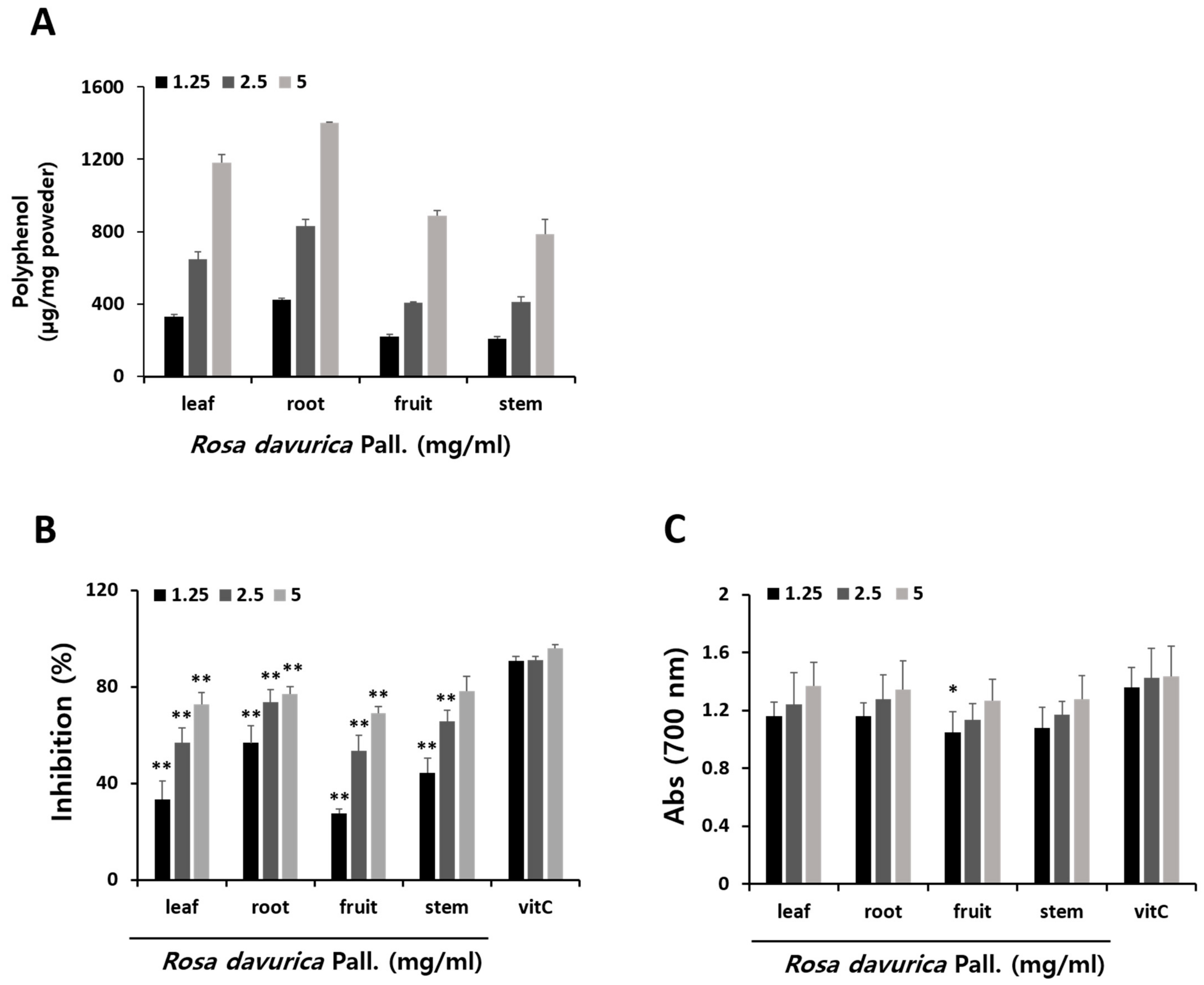
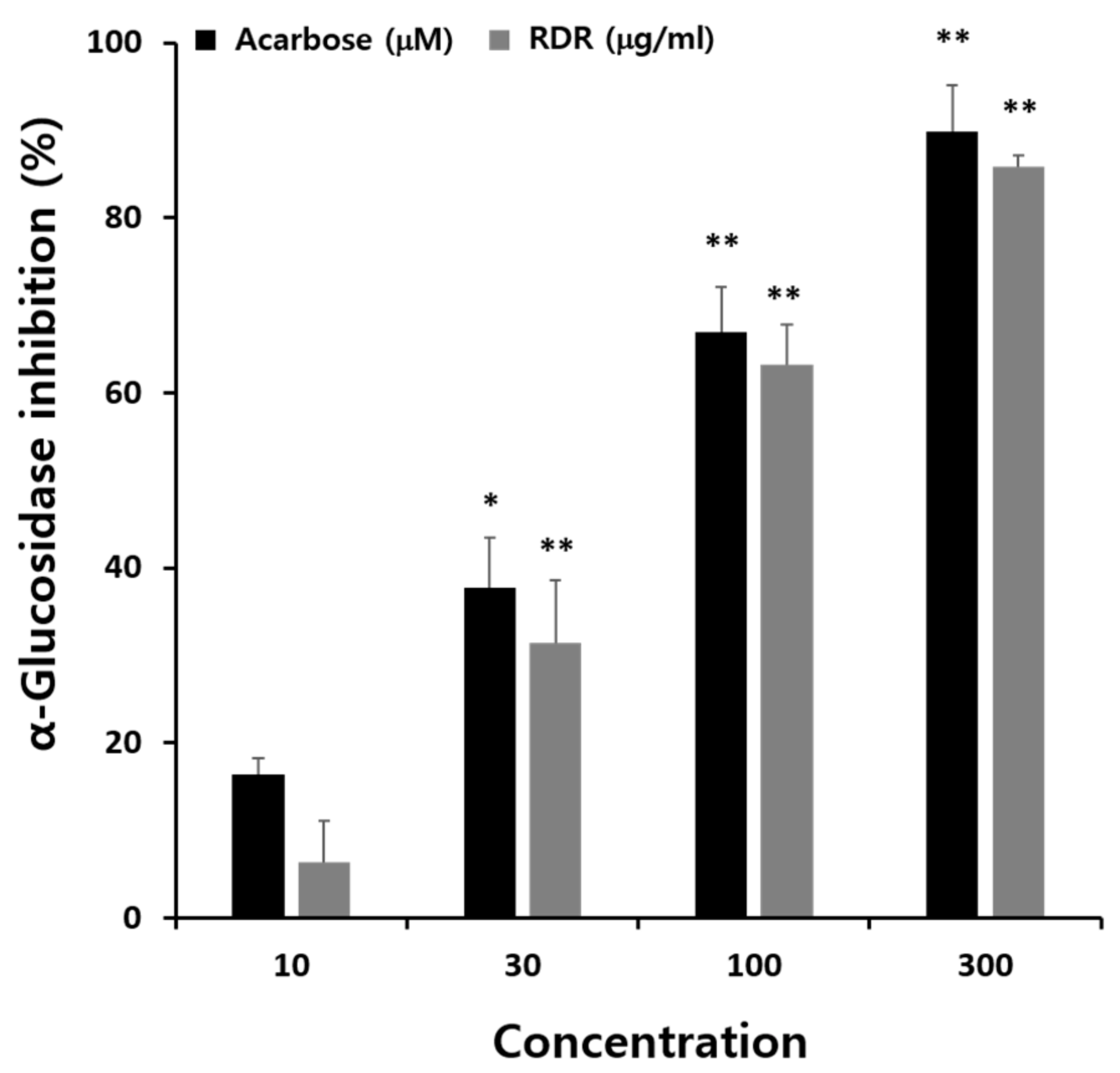

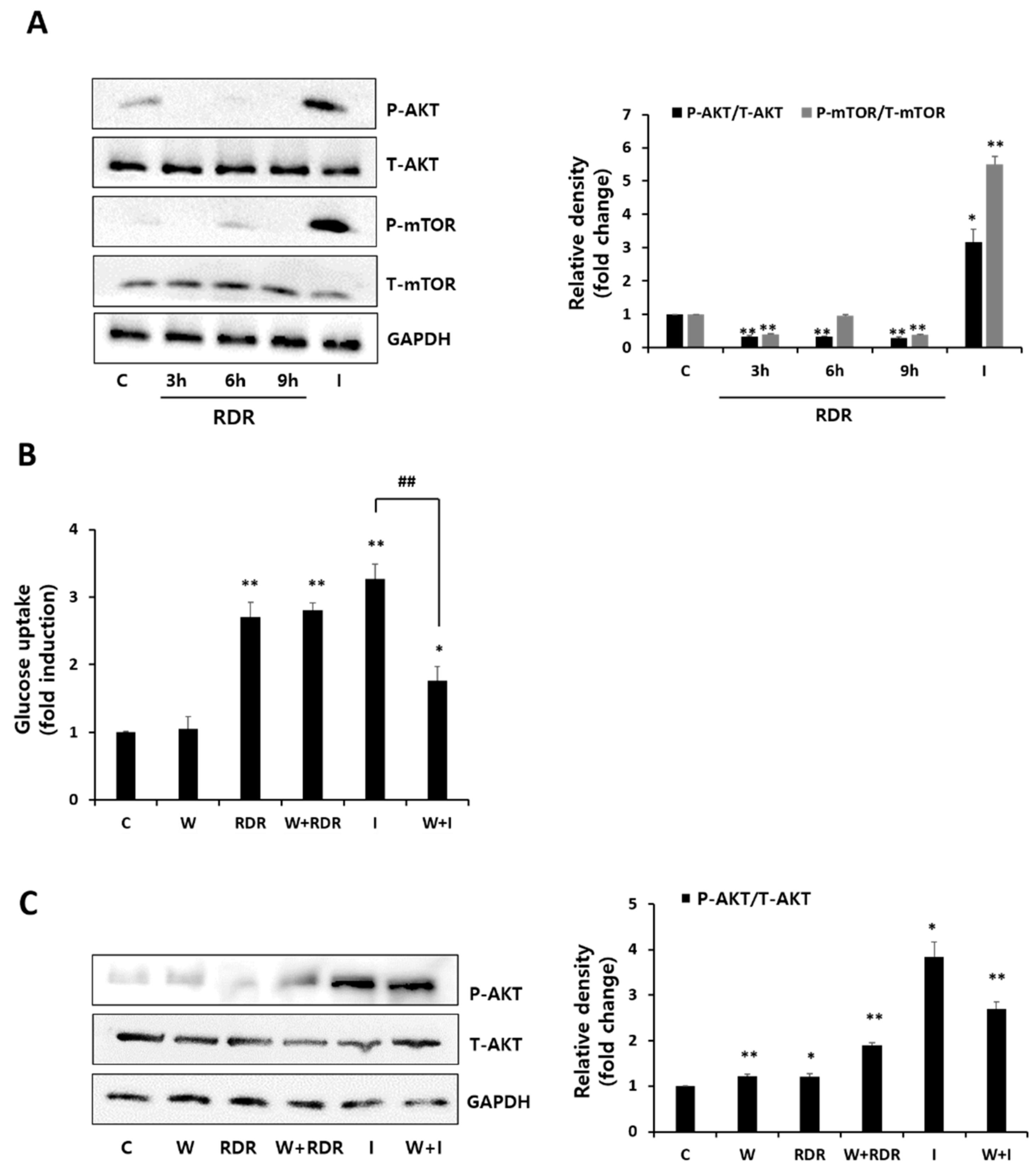
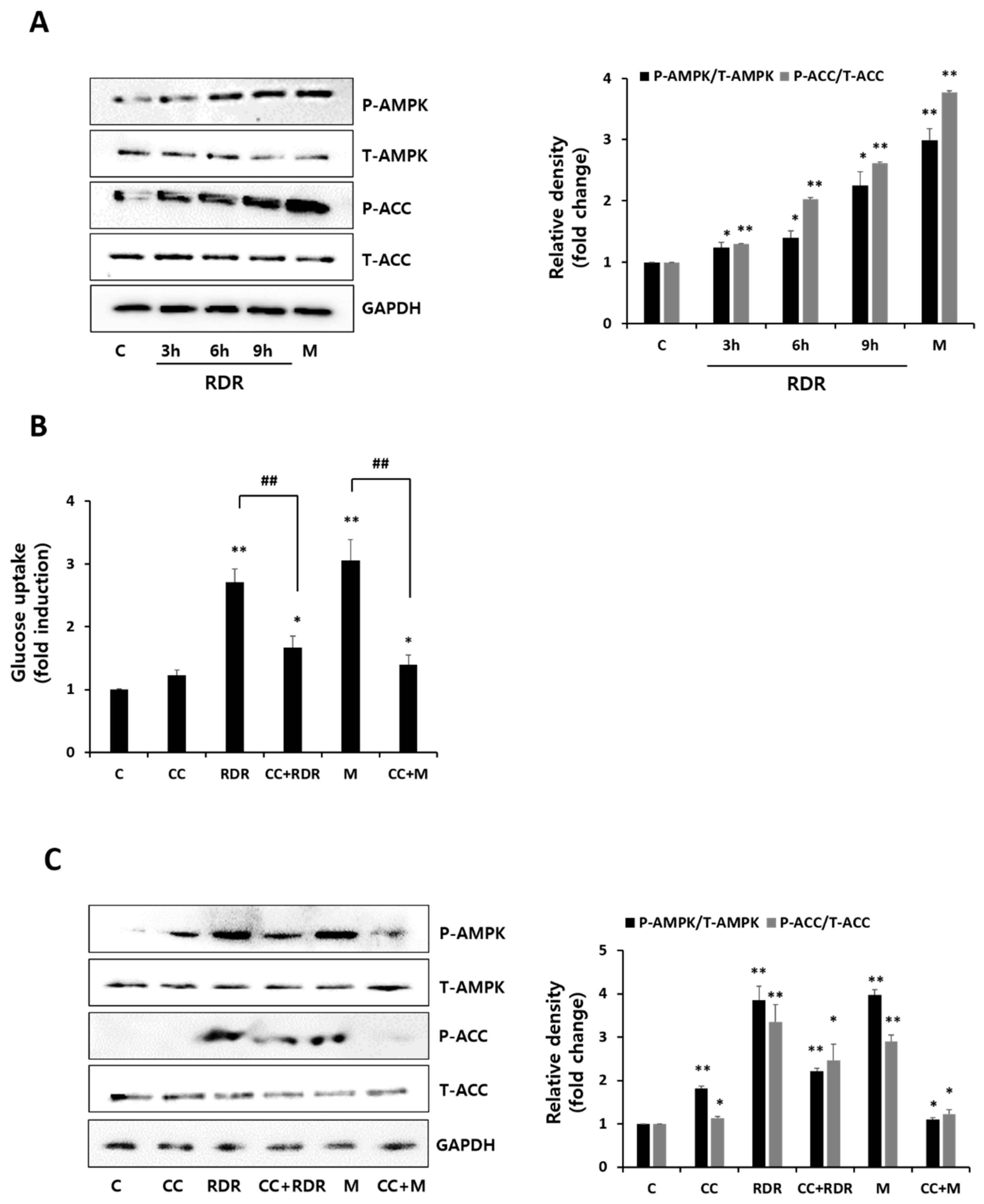
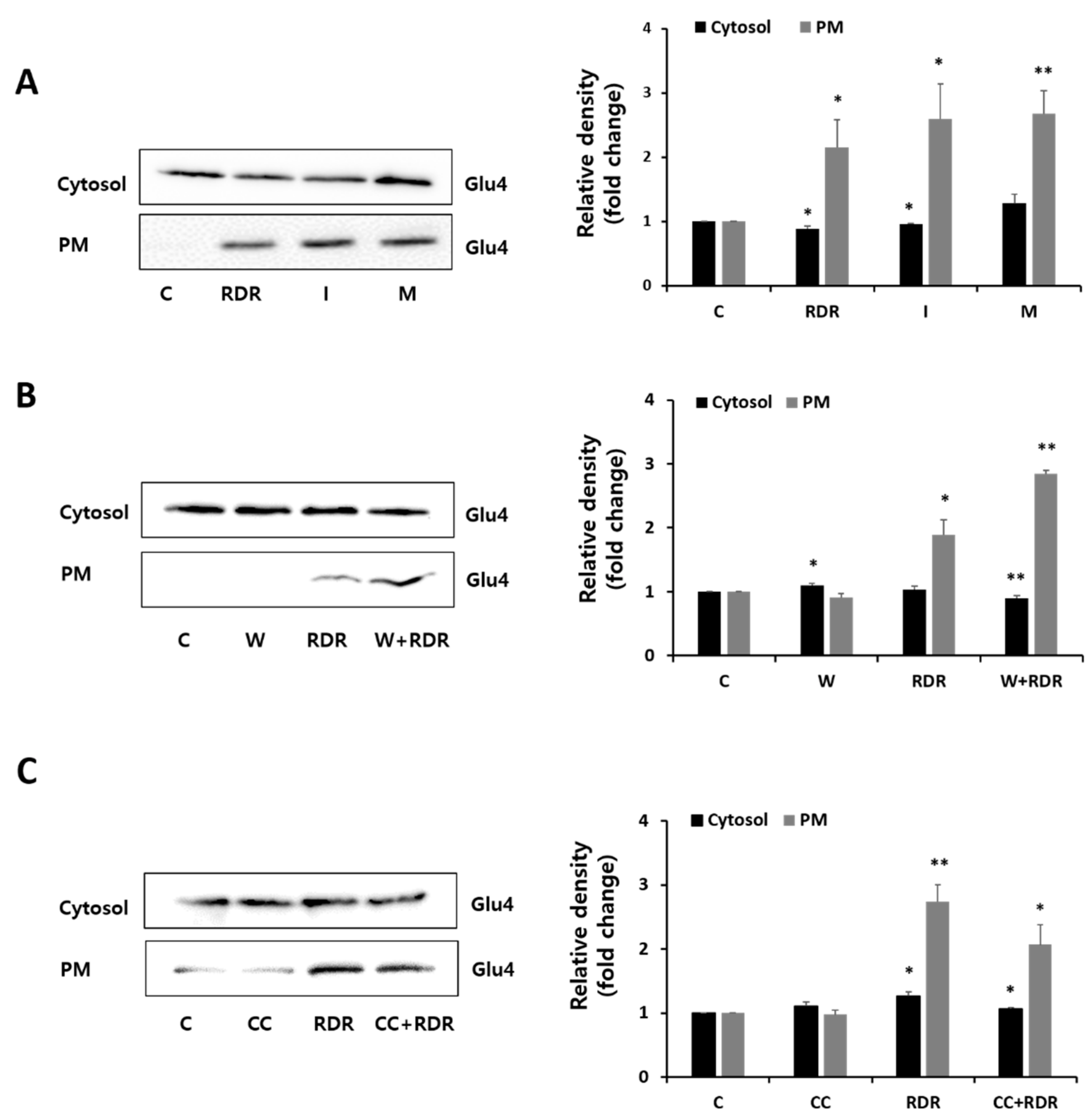

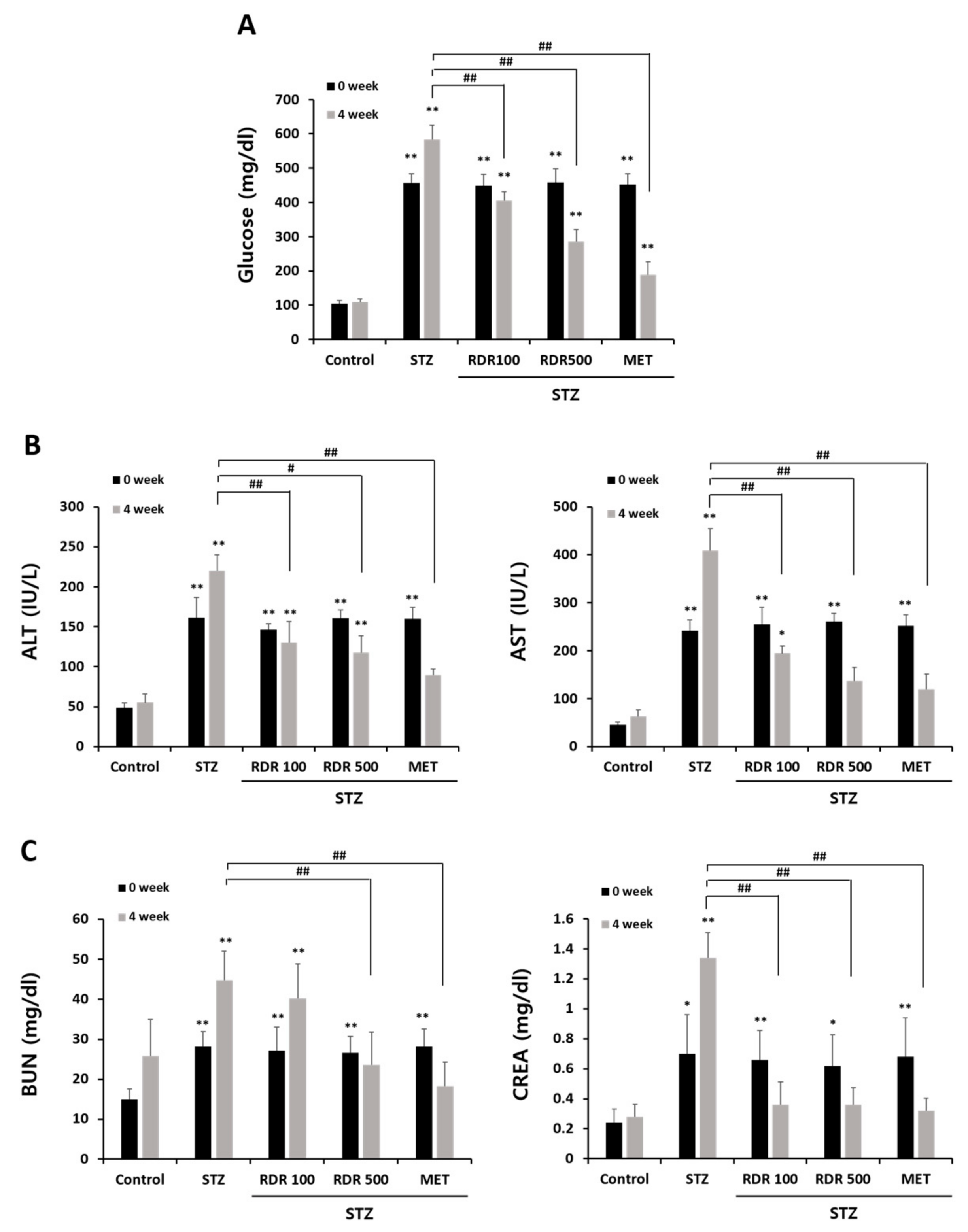
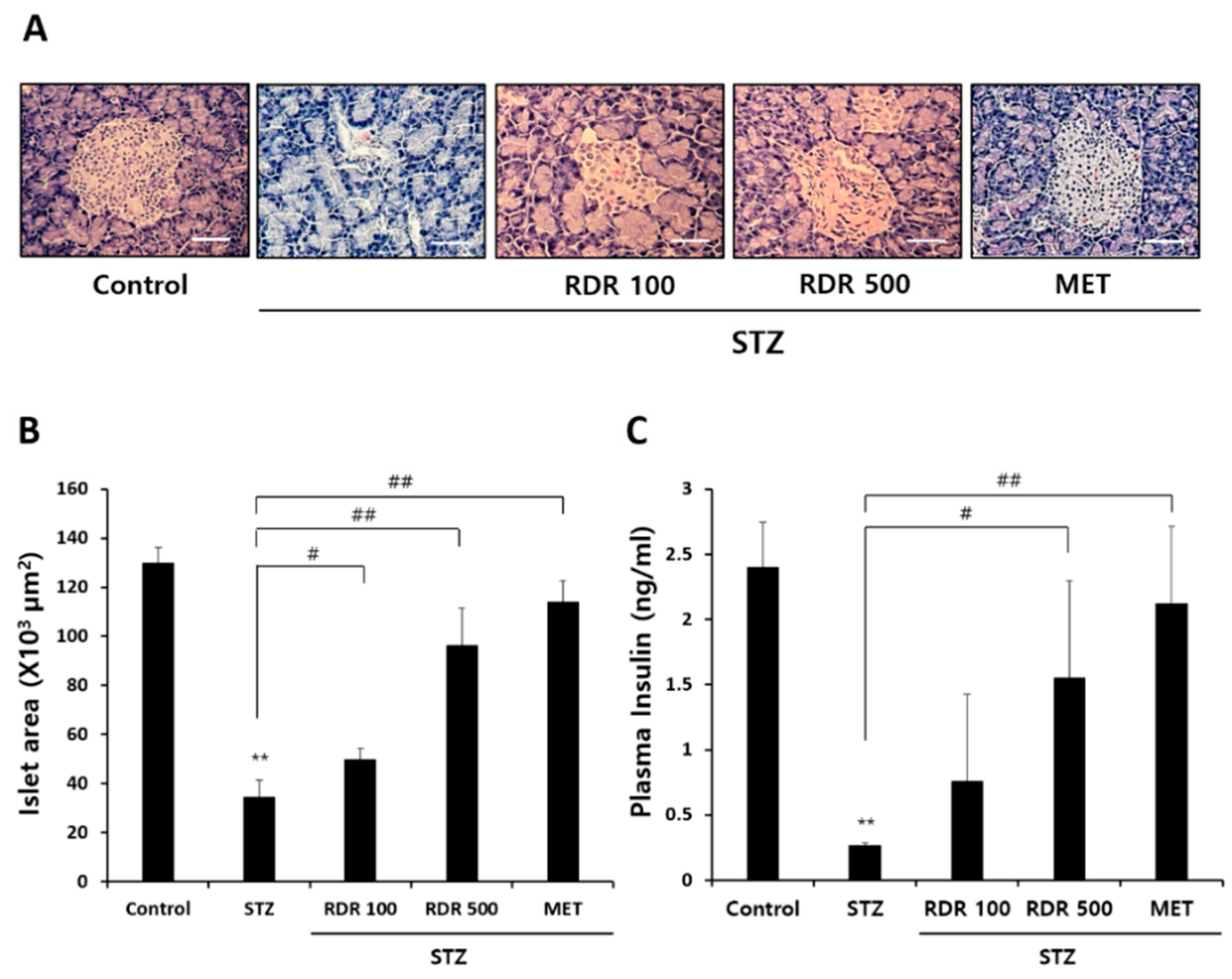
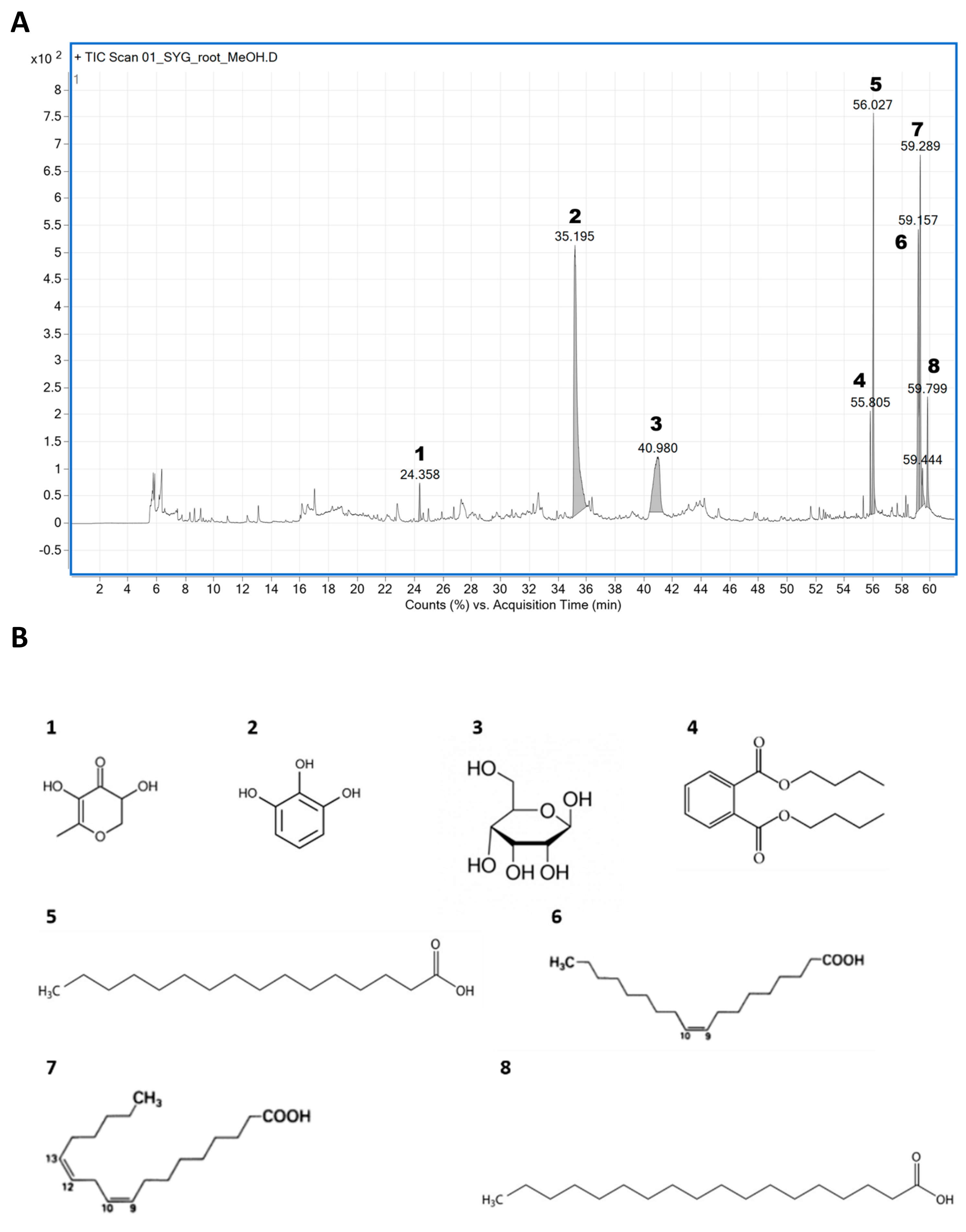

| No. | Retention Time (min) | Compound Name | Molecular Formula | Score (%) | Mass (m/z) | Activity (1) |
|---|---|---|---|---|---|---|
| 1 | 24.358 | 4H-Pyran-4-one, 2,3-dihydro-3,5-dihydroxy-6-methyl-(=DDMP) | C6H8O4 | 71.94 | 144 | Antioxidant, antidiabetic, antimicrobial, anti-inflammatory |
| 2 | 35.195 | 1,2,3-Benzenetriol (=Pyrogallol) | C6H6O3 | 94.58 | 126 | Antimicrobial preservative |
| 3 | 40.980 | D-Allose | C6H12O6 | 79.29 | 180.1 | Antioxidant, antidiabetic, anticancer, |
| 4 | 55.805 | Dibutyl phthalate | C16H22O4 | 95.45 | 278.2 | Antifouling, antimicrobial |
| 5 | 56.027 | n-Hexadecanoic acid (=Palmitic acid) | C16H32O2 | 92.52 | 256.2 | Antioxidant, hypocholesterolemic nematicide, pesticide, lubricant, antiandrogenic, flavor, hemolytic 5-alpha reductase inhibitor |
| 6 | 59.157 | 9,12-Octadecadienoic acid (Z,Z)- (=Linoleic acid) | C18H32O2 | 96.31 | 280.2 | Antioxidant, antidiabetic, anticancer, hypocholesterolemic action |
| 7 | 59.289 | Oleic acid | C18H34O2 | 89.19 | 282.3 | Anti-inflammatory, anti-androgenic cancer preventive, dermatitigenic hypocholesterolemic, 5-alpha reductase inhibitor, anemia genic insectifuge, flavor |
| 8 | 59.799 | Octadecanoic acid (=Stearic acid) | C18H36O2 | 89.09 | 284.3 | Antidiabetic, hypocholesterolemic action |
| Compound Name | AutoDock Score (kcal/mol) | Hydrogen Bond Interactions | Hydrophobic Interactions |
|---|---|---|---|
| 4H-Pyran-4-one, 2,3-dihydro-3,5-dihydroxy-6-methyl-(=DDMP) | −5.5 | 384-HIS, 386-LYS, 387-ASN, 480-GLY | 479-ILE |
| 1,2,3-Benzenetriol (=Pyrogallol) | −5.6 | 36-ASN, 144-ARG | - |
| D-Allose | −6.9 | 56-THR, 110-TYR, 400-ARG | - |
| Dibutyl phthalate | −5.7 | 56-THR | 110-TYR, 143-TYR, 175-ILE, 327-PRO, 396-LEU, 400-ARG, 402-VAL, 483-PRO |
| n-Hexadecanoic acid (=Palmitic acid) | −6.3 | 54-GLY, 436-THR | 70-ILE, 110-TYR, 175-ILE, 327-PRO, 396-LEU, 402-VAL, 459-LEU |
| 9,12-Octadecadienoic acid (Z,Z)- (=Linoleic acid) | −6.0 | 56-THR | 106-PRO, 110-TYR, 175-ILE, 327-PRO, 396-LEU, 402-VAL, 459-LEU, 483-PRO |
| Oleic acid | −5.7 | - | 110-TYR, 327-PRO, 396-LEU, 400-ARG, 402-VAL, 459-LEU, 483-PRO |
| Octadecanoic acid (=Stearic acid) | −5.7 | 110-TYR | 175-ILE, 327-PRO, 396-LEU, 400-ARG, 402-VAL, 459-LEU, 483-PRO |
Disclaimer/Publisher’s Note: The statements, opinions and data contained in all publications are solely those of the individual author(s) and contributor(s) and not of MDPI and/or the editor(s). MDPI and/or the editor(s) disclaim responsibility for any injury to people or property resulting from any ideas, methods, instructions or products referred to in the content. |
© 2024 by the authors. Licensee MDPI, Basel, Switzerland. This article is an open access article distributed under the terms and conditions of the Creative Commons Attribution (CC BY) license (https://creativecommons.org/licenses/by/4.0/).
Share and Cite
Hwang, D.H.; Asirvatham, R.D.; Mohan Prakash, R.L.; Kang, C.; Kim, E. Therapeutic Potential of Rosa davurica Pall. Root Extract as an Antidiabetic Agent: A Comprehensive Analysis from Molecular Mechanisms to In Vivo Efficacy. Int. J. Mol. Sci. 2024, 25, 8944. https://doi.org/10.3390/ijms25168944
Hwang DH, Asirvatham RD, Mohan Prakash RL, Kang C, Kim E. Therapeutic Potential of Rosa davurica Pall. Root Extract as an Antidiabetic Agent: A Comprehensive Analysis from Molecular Mechanisms to In Vivo Efficacy. International Journal of Molecular Sciences. 2024; 25(16):8944. https://doi.org/10.3390/ijms25168944
Chicago/Turabian StyleHwang, Du Hyeon, Ravi Deva Asirvatham, Ramachandran Loganathan Mohan Prakash, Changkeun Kang, and Euikyung Kim. 2024. "Therapeutic Potential of Rosa davurica Pall. Root Extract as an Antidiabetic Agent: A Comprehensive Analysis from Molecular Mechanisms to In Vivo Efficacy" International Journal of Molecular Sciences 25, no. 16: 8944. https://doi.org/10.3390/ijms25168944





